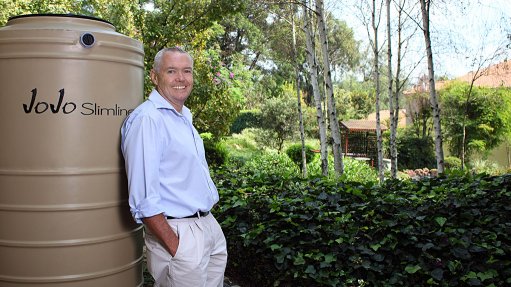
ROD CAIRNS If rainwater is collected and stored over a year, 86% of a household’s water requirements could be met using that water
Rainwater harvesting is the easiest method of water conservation and if we are not collecting rainwater, we are actually wasting water, polyethylene plastic storage tanks manufacturer JoJo Tanks chairperson Rod Cairns tells Engineering News.
If the country is not able to build storage capacity at the same rate at which the population is growing, South Africa will become a more water-constrained society.
“The Hazelmere dam, on the north coast of KwaZulu-Natal, is 37% full. The area is in its dry season, so they have a serious water crisis. In South Africa, we have a strategic storage capacity of about 32-billion cubic metres. By 2035, we are going to need 62-billion cubic metres of storage capacity. Recycling and collecting rainwater can overcome this 30-billion-cubic-metre shortfall,” says Cairns.
The average water consumption per person per day in a city is about 150 ℓ but only 3 ℓ of potable water is needed for consumption.
There are three types of water available for use, namely potable water for consumption, recycled grey water from baths and showers and rainwater. A combination of rainwater and grey water can be used for watering gardens and for swimming pools and washing pets and cars, instead of using potable water.
If rainwater is collected, it can be used in gar-dens, without it first having to pass through expen- sive water processing systems for ultimate use in gardens in the form of expensive potable water.
Cairns says, for every 1 m2 of roof area that has 1 mm of rainfall, 1 ℓ of water can be collected.
“A city house with 150 m2 of roof area that has 10 mm of rain can collect 1 500 ℓ of rainfall. Over a year, with an average rainfall of about 600 mm, one could collect 90 000 ℓ a year off a 150 m2 roof area. It makes sense to collect rainwater but the problem is that it is not deemed to be ‘sexy’ in an urban area. Rural areas have been collecting rainwater for a long time. People only start appreciating the value of water when there is no water,” he explains.
The cost of processing water is going to increase significantly, he warns, and education around rainwater harvesting, especially in urban areas, is vital.
Cairns states that, if rainwater is collected and stored over a year, 86% of a household’s water requirements could be met using that water.
While rainwater harvesting is becoming more topical and gaining momentum slightly, he says, the practice is far from being common- place.
He warns that there is no such thing as free water. The water consumed in Johannesburg, for example, is expensive.
Cairns explains that dams have to be built in Lesotho as part of the Lesotho Highlands Water Project. Following that, the water flows from Lesotho to the Vaal dam, then to water utility Randwater for purification and reticulation. The water is then further reticulated to the various councils. The water is pumped using electricity.
JoJo Tanks has been proactive in skilling local artisans in rainwater harvesting system installation.
The manufacturer has trained plumbers and handymen to calculate tank sizes, to determine where best to fit the tank, how to build a base which has to be constructed correctly and how to undertake the various interconnections from the first filtration to first flush diverter.
It is a bit of a niche skill, says Cairns, adding that JoJo Tanks has trained about 60 people nationally, with another course coming up in July.
The company is also actively campaigning to raise awareness of the benefits of rainwater harvesting.
Residents eager to learn of the various available rainwater harvesting options can also use the rainfall calculator on the JoJo Tanks website: www.jojotanks.co.za.